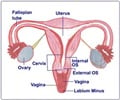Researchers at Indiana University's Kinsey Institute have for the first time shown differences in brain activity as women considered masculinised and feminised male faces, and whether
Researchers at Indiana University's Kinsey Institute have for the first time shown differences in brain activity as women considered masculinised and feminised male faces, and whether the person was a potential sexual partner.
The researchers claim that they have identified regions of the brain that respond more strongly to masculine faces.According to them, the differences between women's preference of masculinized and feminised faces appeared strongest when they were closer to ovulating.
Reported in the journal Evolution and Human Behavior, their study casts light on the link between women's hormone levels and their brain responses to masculinised versus feminised male faces, potentially offering insights into female mate preferences.
The researchers say that their research points towards enhancements of both sensory discrimination and risk processing around ovulation in response to masculine faces as possible mediators of women's mate preferences.
"One area of the brain in which we observed a difference in activation in response to masculinized versus feminized faces -- specifically during the follicular phase -- was the anterior cingulate cortex, which is a region involved in decision-making and the evaluation of potential reward and risk," said neuroscientist Heather Rupp, research fellow at the Kinsey Institute for Research in Sex, Gender and Reproduction at Indiana University.
"Activation in this region has been previously reported to correlate with 'high risk' non-social choices, specifically monetary risk, so it is interesting that it is observed to be more active in response to masculinised male faces, who may be both riskier but more rewarding to women," the researcher added.
Advertisement
Women prefer masculinised faces with features that indicate high levels of testosterone around the time of ovulation, and these facial cues predict high genetic quality in the male because only such males can afford the immune-compromising effects of testosterone.
Advertisement
Around the time of ovulation, a female's preference apparently shifts from avoiding negligent parenting to acquiring the best genes for her offspring.
At other points during the cycle, women tend to prefer more feminised male faces, as they might signal a higher willingness of the males to invest in offspring.
Rupp said that her team undertook the current study to determine the link between hormone levels and brain responses to masculinised versus feminised male faces.
She revealed that the pictures of 56 male faces used for the study were masculinized and feminized using standard computer-morphing software.
Twelve heterosexual women, averaging about 25 years old, were tested during the follicular phase, which is closer to ovulation and higher fertility time, and the luteal phases of their menstrual cycles. Before each test session their blood was collected for hormone analyses.
While brain activity was measured using functional Magnetic Resonance Imaging, women viewed the masculinised and feminised male faces, indicating their interest in the man depicted as a potential sexual partner.
The research group found differences in brain regions related to face perception, decision making and reward processing that responded more strongly to masculinised than feminized faces, suggesting that "neural activation in response to face stimuli is sensitive to facial masculinization, even in the absence of differences in subjective ratings."
Differences between masculinized and feminized faces appeared strongest during the follicular phase, closer to ovulation.
Source-ANI
SPH










